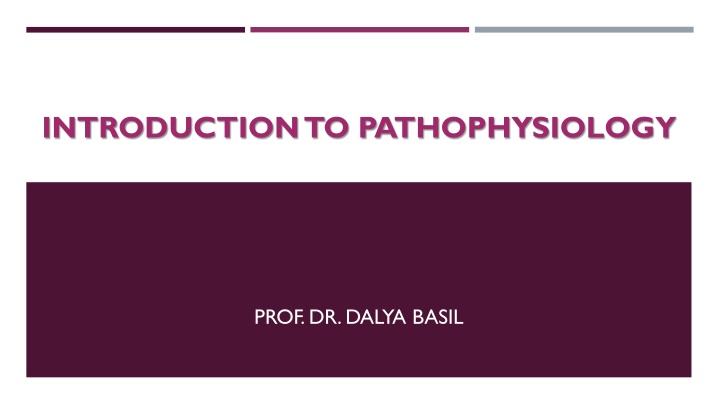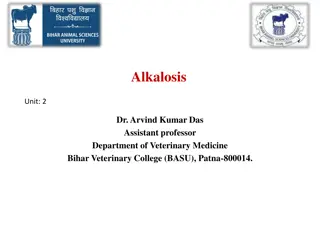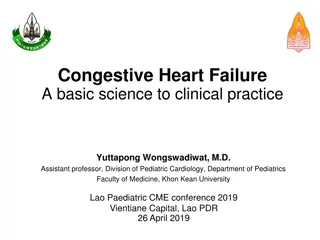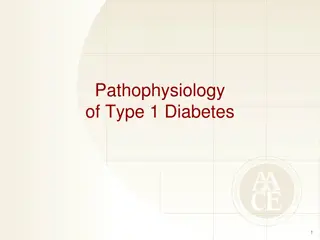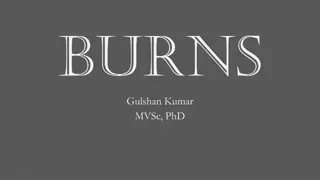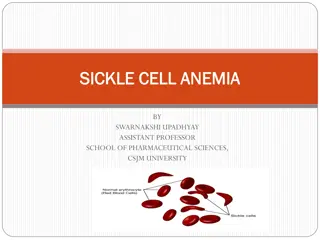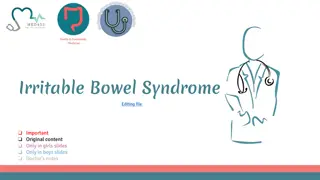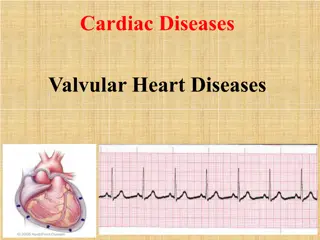INTRODUCTION TO PATHOPHYSIOLOGY
Pathophysiology combines pathology and physiology to study the cellular and organ changes that occur with disease and their effects on total body function. Explore disease processes, etiology, and risk factors in health care practices.
Download Presentation

Please find below an Image/Link to download the presentation.
The content on the website is provided AS IS for your information and personal use only. It may not be sold, licensed, or shared on other websites without obtaining consent from the author.If you encounter any issues during the download, it is possible that the publisher has removed the file from their server.
You are allowed to download the files provided on this website for personal or commercial use, subject to the condition that they are used lawfully. All files are the property of their respective owners.
The content on the website is provided AS IS for your information and personal use only. It may not be sold, licensed, or shared on other websites without obtaining consent from the author.
E N D
Presentation Transcript
INTRODUCTION TO PATHOPHYSIOLOGY PROF. DR. DALYA BASIL
INTRODUCTION The term pathophysiology, may be defined as the physiology of altered health. The term combines the words pathology and physiology. Pathology (from the Greek pathos, meaning disease ) deals with the study of the structural and functional changes in cells, tissues, and organs of the body that cause or are caused by disease. Physiology deals with the functions of the human body. Thus,pathophysiology deals not only with the cellular and organ changes that occur with disease, but with the effects that these changes have on total body function. Pathophysiology also focuses on the mechanisms of the underlying disease process and provides the background for preventive as well as therapeutic health care measures and practices.
INTRODUCTION Disease: A disease has been defined as an interruption, cessation, or disorder of a body system or organ structure that is characterized usually by a recognized etiologic agent or agents, an identifiable group of signs and symptoms,or consistent anatomic alterations. The aspects of the disease process include etiology, pathogenesis, morphologic changes, clinical manifestations, diagnosis, and clinical course.
INTRODUCTION Etiology: The causes of disease are known as etiologic factors. Among the recognized etiologic agents are biologic agents (e.g., bacteria, viruses), physical forces (e.g., trauma, burns, radiation), chemical agents (e.g., poisons, alcohol), and nutritional excesses or deficits. At the molecular level,it is important to distinguish between abnormal molecules and molecules that cause disease.This is true of diseases such as cystic fibrosis,sickle cell anemia,and familial hypercholesterolemia,in which the genetic abnormality of a single amino acid, transporter molecule, or receptor protein produces widespread effects on health.
INTRODUCTION Most disease-causing agents are nonspecific, and many different agents can cause disease of a single organ. On the other hand, a single agent or traumatic event can lead to disease of a number of organs or systems.Although a disease agent can affect more than a single organ and a number of disease agents can affect the same organ, most disease states do not have a single cause. Instead, the majority of diseases are multifactorial in origin. This is particularly true of diseases such as cancer, heart disease, and diabetes. The multiple factors that predispose to a particular disease often are referred to as risk factors.
INTRODUCTION One way to view the factors that cause disease is to group them into categories according to whether they were present at birth or acquired later in life. Congenital conditions are defects that are present at birth, although they may not be evident until later in life. Congenital conditions may be caused by genetic influences, environmental factors (e.g., viral infections in the mother, maternal drug use, irradiation),or a combination of genetic and environmental factors. Acquired defects are those that are caused by events that occur after birth. These include injury, exposure to infectious agents, inadequate nutrition, lack of oxygen, inappropriate immune responses, and neoplasia. Many diseases are thought to be the result of a genetic predisposition and an environmental event or events that serve as a trigger to initiate disease development.
INTRODUCTION Pathogenesis: is the sequence of cellular and tissue events that take place from the time of initial contact with an etiologic agent until the ultimate expression of a disease. Etiology describes what sets the disease process in motion, and pathogenesis, how the disease process evolves. Although the two terms often are used interchangeably, their meanings are quite different. For example, atherosclerosis often is cited as the cause or etiology of coronary heart disease. In reality, the progression from fatty streak to the occlusive vessel lesion seen in persons with coronary heart disease represents the pathogenesis of the disorder.The true etiology of atherosclerosis remains largely uncertain.
INTRODUCTION Morphology: refers to the fundamental structure or form of cells or tissues. Morphologic changes are concerned with both the gross anatomic and microscopic changes that are characteristic of a disease. Histology deals with the study of the cells and extracellular matrix of body tissues. The most common method used in the study of tissues is the preparation of histologic sections thin, translucent sections of human tissues and organs that can be examined with the aid of a microscope. Histologic sections play an important role in the diagnosis of many types of cancer. A lesion represents a pathologic or traumatic discontinuity of a body organ or tissue. Descriptions of lesion size and characteristics often can be obtained ultrasonography, and other imaging methods. Lesions also may be sampled by biopsy and the tissue samples subjected to histologic study. through the use of radiographs,
INTRODUCTION Clinical Manifestations:Diseases can manifest in a number of ways.Sometimes the condition produces manifestations, such as fever,that make it evident that the person is sick. In other cases, the condition is silent at the onset and is detected during examination for other purposes or after the disease is far advanced. Signs and symptoms are terms used to describe the structural and functional changes that accompany a disease. A symptom is a subjective complaint that is noted by the person with a disorder,whereas a sign is a manifestation that is noted by an observer. Pain, difficulty in breathing, and dizziness are symptoms of a disease. An elevated temperature, a swollen extremity, and changes in pupil size are objective signs that can be observed by some-one other than the person with the disease.
INTRODUCTION Signs and symptoms may be related to the primary disorder or they may represent the body s attempt to compensate for the altered function caused by the pathologic condition. Many pathologic states are not observed directly one cannot see a sick heart or a failing kidney. Instead, what can be observed is the body s attempt to compensate for changes in function brought about by the disease, such as the tachycardia that accompanies blood loss or the increased respiratory rate that occurs with pneumonia. A syndrome is a compilation of signs and symptoms (e.g., chronic fatigue syndrome) that are characteristic of a specific disease state. Complications are possible adverse extensions of a disease or outcomes from treatment. Sequelae are lesions or impairments that follow or are caused by a disease.
INTRODUCTION Diagnosis: A diagnosis is the designation as to the nature or cause of a health problem (e.g., bacterial pneumonia or hemorrhagic stroke). The diagnostic process usually requires a careful history and physical examination. The history is used to obtain a person s account of his or her symptoms and their progression,and the factors that contribute to a diagnosis. The physical examination is done to observe for signs of altered body structure or function.
INTRODUCTION The development of a diagnosis involves weighing competing possibilities and selecting the most likely one from among the conditions that might be responsible for the person s clinical presentation. The clinical probability of a given disease in a person of a given age,sex,race,lifestyle, and locality often is influential in arrival at a presumptive diagnosis. Laboratory tests, radiologic studies, computed tomography (CT) scans, and other tests often are used to confirm a diagnosis.
INTRODUCTION Clinical Course: The clinical course describes the evolution of a disease. A disease can have an acute,subacute,or chronic course. An acute disorder is one that is relatively severe,but self-limiting. Chronic disease implies a continuous, long-term process. A chronic disease can run a continuous course or can present with exacerbations (aggravation of symptoms and severity of the disease) and remissions (a period during which there is a decrease in severity and symptoms). Subacute disease is intermediate or between acute and chronic: it is not as severe as an acute disease and not as prolonged as a chronic disease.
INTRODUCTION The spectrum of disease severity for infectious diseases,such as hepatitis B,can range from preclinical to persistent chronic infection. During the preclinical stage, the disease is not clinically evident but is destined to progress to clinical disease. As with hepatitis B,it is possible to transmit a virus during the preclinical stage. Subclinical disease is not clinically apparent and is not destined to become clinically apparent. It is diagnosed with antibody or culture tests. Clinical disease is manifested by signs and symptoms. A persistent chronic infectious disease persists for years, sometimes for life. Carrier status refers to an individual who harbors an organism but is not infected, as evidenced by antibody response or clinical manifestations. This person still can infect others. Carrier status may be of limited duration or it may be chronic, lasting for months or years.
INTRODUCTION Epidemiology and Patterns of Disease: Epidemiology is the study of disease occurrence in human populations. It was initially developed to explain the spread of infectious diseases during epidemics and has emerged as a science to study risk factors for multifactorial diseases,such as heart disease and cancer. Epidemiology looks for patterns of persons affected with a particular disorder, such as age, race, dietary habits, lifestyle, or geographic location. In contrast to biomedical researchers, who seek to elucidate the mechanisms of disease production, epidemiologists are more concerned with whether something happens than how it happens.
INTRODUCTION For example, the epidemiologist is more concerned with whether smoking itself is related to cardio-vascular disease and whether the risk of heart disease decreases when smoking ceases. On the other hand, the biomedical researcher is more concerned about the causative agent in cigarette smoke and the pathway by which it contributes to heart disease. Morbidity and mortality statistics provide information about the functional effects (morbidity) and death-producing (mortality) characteristics of a disease. These statistics are useful in terms of anticipating health care needs, planning of public education programs, directing health research efforts, and allocating health care dollars.
INTRODUCTION Determination of Risk Factors: Conditions suspected of contributing to the development of a disease are called risk factors. They may be inherent to the person (high blood pressure or overweight) or external (smoking or drinking alcohol).There are different types of studies used to determine risk factors,including cross-sectional studies, case-control studies, and cohort studies. Cross-sectional studies use the simultaneous collection of information necessary for classification of exposure and outcome status. They can be used to compare the prevalence of a disease in those with the factor (or exposure) with the prevalence of a disease in those who are unexposed to the factor,such as the prevalence of coronary heart disease in smokers and non-smokers.
INTRODUCTION Case-control studies are designed to compare persons known to have the outcome of interest (cases) and those known not to have the outcome of interest (controls). characteristics of interest is then collected from persons in both groups. For example, the characteristics of maternal alcohol consumption in infants born with fetal alcohol syndrome (cases) can be compared with those in infants born without the syndrome (controls). Information on exposures or
INTRODUCTION A cohort is a group of persons who were born at approximately the same time or share some characteristics of interest. Persons enrolled in a cohort study (also called a longitudinal study) are followed over a period of time to observe a specific health outcome. A cohort may consist of a single group of persons chosen because they have or have not been exposed to suspected risk factors; two groups specifically selected because one has been exposed and the other has not; or a single exposed group in which the results are compared with the general population.
INTRODUCTION Natural History: The natural history of a disease refers to the progression and projected outcome of the disease without medical intervention. By studying the patterns of a disease over time in populations, epidemiologists can better understand its natural history. Knowledge of the natural history can be used to determine disease outcome,establish priorities for health care services,determine the effects of screening and early detection programs on disease outcome,and compare the results of new treatments with the expected outcome without treatment. There are some diseases for which there are no effective treatment methods available, or the current treatment measures are effective only in certain people. In this case,the natural history of the disease can be used as a predictor of outcome.
INTRODUCTION For example, the natural history of hepatitis C indicates that 80% of people who become infected with the virus fail to clear the virus and progress to chronic infection. Information about the natural history of a disease and the availability of effective treatment methods provides directions for preventive measures. In the case of hepatitis C, careful screening of blood donations and education of intravenous drug abusers can be used to prevent transfer of the virus. At the same time, scientists are striving to develop a vaccine that will prevent infection in persons exposed to the virus.
CELLULAR ADAPTATION The environment around cells is dynamic and constantly changing. In this fluid environment, cells are exposed to numerous stimuli, some of which may be injurious. To survive, cells must have the ability to adapt to variable conditions. This process of adaptation can involve changes in cellular size,number or type. Cells are able to adapt to increased work demands or threats to survival by changing their size (atrophy and hypertrophy),number (hyperplasia),and form (metaplasia). Normal cellular adaptation occurs in response to an appropriate stimulus and ceases once the need for adaptation has ceased.
CELLULAR ADAPTATION Cellular adaptation: 1.Atrophy: - Decrease in size of a cell or tissue. - Decreased size results in decreased oxygen consumption and metabolic needs of the cells and may increase the overall efficiency of cell function. - Atrophy is generally a reversible process, except for atrophy caused by loss of nervous innervation to a tissue. - Causes of atrophy include prolonged bed rest, disuse of limbs or tissue, poor tissue nutrition and ischemia.
ATROPHY Normal cells Nucleus Basement membrane Atrophy
CELLULAR ADAPTATION 2- Hypertrophy: Increase in cell size and tissue mass. Occurs when a cell or tissue is exposed to an increased workload. Occurs in tissues that cannot increase cell number as an adaptive response. Hypertrophy may be a normal physiologic response, such as the increase in muscle mass that is seen with exercise, or it may be pathologic as in the case of the cardiac hypertrophy that is seen with prolonged hypertension. Hypertrophy may also be a compensatory process. When one kidney is removed, for example, the remaining kidney hypertrophies to increase its functional capacity.
MYOCARDIAL HYPERTROPHY: CROSS-SECTION OF THE HEART IN A PATIENT WITH LONG-STANDING HYPERTENSION
CELLULAR ADAPTATION 3- Hyperplasia: Increase in the number of cells in an organ or tissue. Can only occur in cells capable of mitosis (therefore,not muscle or nerve cells). The stimuli that induce hyperplasia may be physiologic or nonphysiologic. There are two common types of physiologic hyperplasia:hormonal and compensatory.
CELLULAR ADAPTATION Breast and uterine enlargement during pregnancy are examples of a physiologic hyperplasia that results from estrogen stimulation. The regeneration of the liver that occurs after partial hepatectomy (i.e., partial removal of the liver) is an example of compensatory hyperplasia. Hyperplasia is also an important response of connective tissue in wound healing, during which proliferating fibroblasts and blood vessels contribute to wound repair. Although hypertrophy and hyperplasia are two distinct processes, they may occur together and are often triggered by the same mechanism. For example, the pregnant uterus undergoes both hypertrophy and hyperplasia as a result of estrogen stimulation.
CELLULAR ADAPTATION Most forms of nonphysiologic hyperplasia are due to excessive hormonal stimulation or the effects of growth factors on target tissues. Excessive estrogen production can cause endometrial hyperplasia and abnormal menstrual bleeding. Benign prostatic hyperplasia, which is a common disorder of men older than 50 years of age, is thought to be related to the action of androgens. Skin warts are an example of hyperplasia caused by growth factors produced by certain viruses, such as the papillomaviruses.
CELLULAR ADAPTATION Metaplasia: The conversion of one cell type to another cell type that might have a better chance of survival under certain circumstances. Metaplasia usually occurs in response to chronic irritation or inflammation. An example of metaplasia occurs in the respiratory passages of chronic cigarette smokers. Following years of exposure to irritating cigarette smoke, the ciliated columnar epithelium lining the respiratory passages gradually converts to stratified squamous epithelium. Although the stratified squamous cells may be better able to survive the constant irritation of cigarette smoke, they lack the cilia of the columnar epithelial cells that are necessary for clearing particulates from the surfaces of the respiratory passages.
CELLULAR ADAPTATION Dysplasia: A derangement of cell growth that leads to tissues with cells of varying size, shape and appearance. Generally occurs in response to chronic irritation and inflammation. Dysplasia may be a strong precursor to cancer in certain instances such as in the cervix or respiratory tract.
